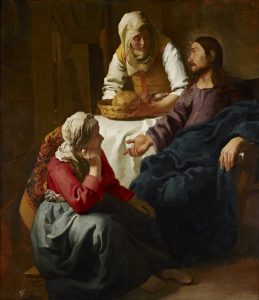Words on the Word
16. Sunday C
Genesis 18.1-10: Abraham hastened. ‘Hurry’, he said.
Colossians 1.24-28: The mystery of Christ is among you.
Luke 10.38-42: Martha was distracted with all the serving.
Martha and Mary are a reference far beyond Christian and Biblical circles, seen as opposite character types, Enneagram-codes in conflict. This is too reductive, though. The Gospel account does not dichotomise. It does not idealise the contemplative and demonise the cook; and the Church, introducing this pericope with the account of Abraham’s hospitality, when this ancient man rushed to give his guests the very best, instructs us not to condemn Martha. Her function is vital, so is her generous attention. Where she is at fault is in her distraction. Martha and Mary are not in opposition, but called to be one.
One of the best disquisitions I know about the sisters’ complementarity is a poem by Rumer Godden appended to a letter written to Dame Felicitas Corrigan, a nun of Stanbrook, in 1964, sent off from New Delhi. The text is marked, ‘only doggerel I fear’, but is really a splendid piece of writing. It was published in Benedictine Tapestry, pp. 171-3. Here it is:
I think often of that house in Bethany:
It would have a flat roof, thick walls, a trellis of morning glory
perhaps, in a courtyard open to sun and the Jerusalem stars.
Dark cool rooms inside; in the kitchen a clay oven and water-jars
(I think of the wedding in Cana when water was changed into wine).
There was an arbour, perhaps, where, on His visits, He sat in the shade of a vine
looking out over Lazarus’s almonds and lemons, the sun-eaten olive groves,
While from the road came whip-cracks, footsteps in dust,
The pricking of donkey hooves
And, from the house, a coin-toss bustle and quiet, Martha and Mary.
Yes, I think often about the house in Bethany:
because it is no legend or old history:
Bethany is my village, your town or street, everywhere.
Martha’s brisk plaits, the veil on Mary’s hair,
both throw my shadow on the wall of the lighted sitting-room,
antagonists in every woman as every day she makes her home:
and Martha forever has no time to waste —
Her tribute is the supper — Mary knows a richer feast.
Yet there is a sigh,
Wistful, eternal:
‘If I could be that worth of rubies.’
‘Could find that single pearl.’
‘If I could talk to Him as Mary can.’
‘I I could welcome Him as Martha can
with a fragrance of baking, and spiced and sizzling meat.’
‘But Mary brought the ointment to pour on His feet.’
‘I shrill into talk or gossip.
Mary listens: her voice is low
but her words are a blossom that bears.’
‘If I had Martha’s hand with dough.’
‘Jesus! To see this picture
my eyes need Your touch of spittle and clay.’
‘Martha’s busy spindle
shames my dreaming day.’
’The great names belong to Mary,
Sappho, Beatrice, Teresa, they echo on and on.’
‘Martha is more than names,
she is everyone.’
‘Mary takes an adventurous road;
a squirrel’s wheel taunts my dailiness.’
‘How scarred and stained I am
beside Martha’s cleanliness.’
‘If I had loved as she loved
greatly.’ ‘If I knew her content.’
‘How wisely Martha saved.’
‘How magnificently Mary spent.’
But He said He would be
in bread
as well as wine;
and there was something
else he said:
‘Let your light
shine’ —
homely, votive, midnight
and when the everyday of every
day, January to December,
acquaints
us with our dim flickering,
remember:
Martha and Mary,
both were saints.

The sisters as Vermeer imagined them. The painting is in the National Gallery of Scotland.

